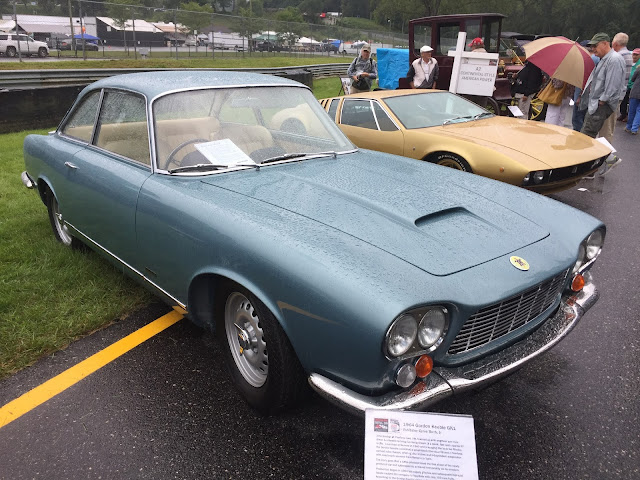A sharp-eyed reader* captured the two cars below at a rainy vintage car gathering at Lime Rock this autumn. He'd never seen an example of the blue car in the foreground. Though the turtle insignia on the nose seemed a mystery, it appears whoever determined the parking order knew something about it, because they placed the mystery car next to another car by the same Italian body designer, Giorgetto Giugiaro.

The turtle emblem on the car's nose gives little clue as to the car's origins, and certainly no clue of its performance potential. But one thing this silver-blue Grodon-Keeble GK-1 shares with that bronze Mangusta beyond its body designer is American power. The 1960 Bertone-bodied GK-1 prototype ran with a Chevy 283, while the Ghia-built Mangusta designed half a dozen years later featured a midship-mounted Ford 289. What was the Gordon-Keeble, and what's that turtle doing on its prow?
Well, it started with the Peerless, a coupe with a tubular space frame chassis, De Dion tube rear suspension and Triumph TR3 engine. The design by Bernie Rodgers for partners John Gordon and James Byrnes was built in an old tank factory operated in World War I by the namesake American Peerless car company. After the alloy-paneled prototype, Peerless built around 325 fiberglass-bodied GTs from 1957 through 1960.
After Peerless ran out of funding, designer Rodgers managed to build another 40 Warwick GT cars from 1960-62, including 2 with the aluminum Buick V8 that appeared a few years later in Rovers. At the same time, a guy named Jim Keeble (who'd also tried the Buick in his Peerless) went into partnership with John Gordon, with a plan to make a V8-powered GT based on the Peerless chassis, but with a new body design.
Gordon and Keeble apparently felt that styling of the Peerless and Warwick (2 examples above) was somewhat lacking in any strong theme. They had more confidence in the Peerless chassis design, and re-used all the basic elements, adding rear disc brakes to join the ones at the front, and moving the twin fuel tanks from their risky and space-robbing position below the Peerless doors. For styling, they approached Bertone in 1959...
The Giugiaro-designed GK-1 prototype wowed crowds when it appeared at the 1960 Geneva Show. Tightly contoured around the space frame and with a glassy cabin, it was the picture of modernity; the E-Type Jaguar was 13 months in the future. The prototype impressed GM execs enough that they promised to supply Chevrolet V8s for the production cars…327s instead of the 283 in the prototype they tested. In those fiberglass-bodied production cars, 0 to 60 came up in under 6 seconds, with a top speed around 140 mph. As with many largely handbuilt cars, detail differences between examples show up…for example, the more circular wheel openings on the dark blue car below, compared with the ovoid openings on our silver-blue mystery car. They all got the turtle emblem though, because a pet turtle had wandered into a photo shoot of that first GK-1. It was adopted as a good luck mascot...
But the partners' luck didn't hold. For one thing, they'd underestimated how long it would take to get the new car into production. The first production GK-1 emerged from their plant in 1964, nearly 4 years after the first showing. As we shall see, this allowed some competitors (even some with American V8 engines) to beat them to the market. Gordon and Keeble had also underestimated production costs. By the time production ended in 1967, they'd sold 99 cars; one more was assembled from stock after the closure. A later effort by De Bruyne with an uninspired restyle resulted in one completed car. The problem with the GK-1 was, after all, not lack of styling; it was lack of a cost accountant.
Even though the Gordon-Keeble team failed in their mission of filling thousands of garages in America and the Mother Country with sort-of-affordable American-powered, Italian-tailored, British-built GTs, they may have provided what we'd call "proof of concept" to Milanese industrialist Renzo Rivolta, who commissioned Bertone to come up with a 2+2 GT car not long after the Gordon-Keeble first appeared. Designer Giugiaro applied similar proportions and greenhouse design to the steel-bodied, Chevy 327-powered Iso Rivolta GT* that went into production in 1962. This example was parked not far from the GK-1. Over 8 years of production, 8 times as many of this Iso were produced as of the Gordon-Keeble, partly reflecting the penalty imposed by the 4-year delay in getting Gordon's GT into production. Eight years after Gordon-Keeble folded its tent, Iso Rivolta was bankrupted by slow sales prompted by the 1973 fuel crisis. Both stories demonstrate that a good way of getting rid of all your money during this era was to manufacture exotic cars...
*Footnote: Giugiaro's De Tomaso Mangusta design was pictured and analyzed in "The Italian Line: Ghia Part 2—From Custom to Corporate", posted October 31, 2020. We surveyed Iso Rivolta history in "Born From Refrigerators: Iso Rivolta", posted September 20, 2018.
Photo Credits:
*Top & bottom photos: LCDR Jonathan D. Asbury, USN.
2nd, 3rd & 6th: Wikimedia
4th: en.wheelsage.org
5th: gordtonkeeble.org.uk
7th: pinterest.com







No comments:
Post a Comment